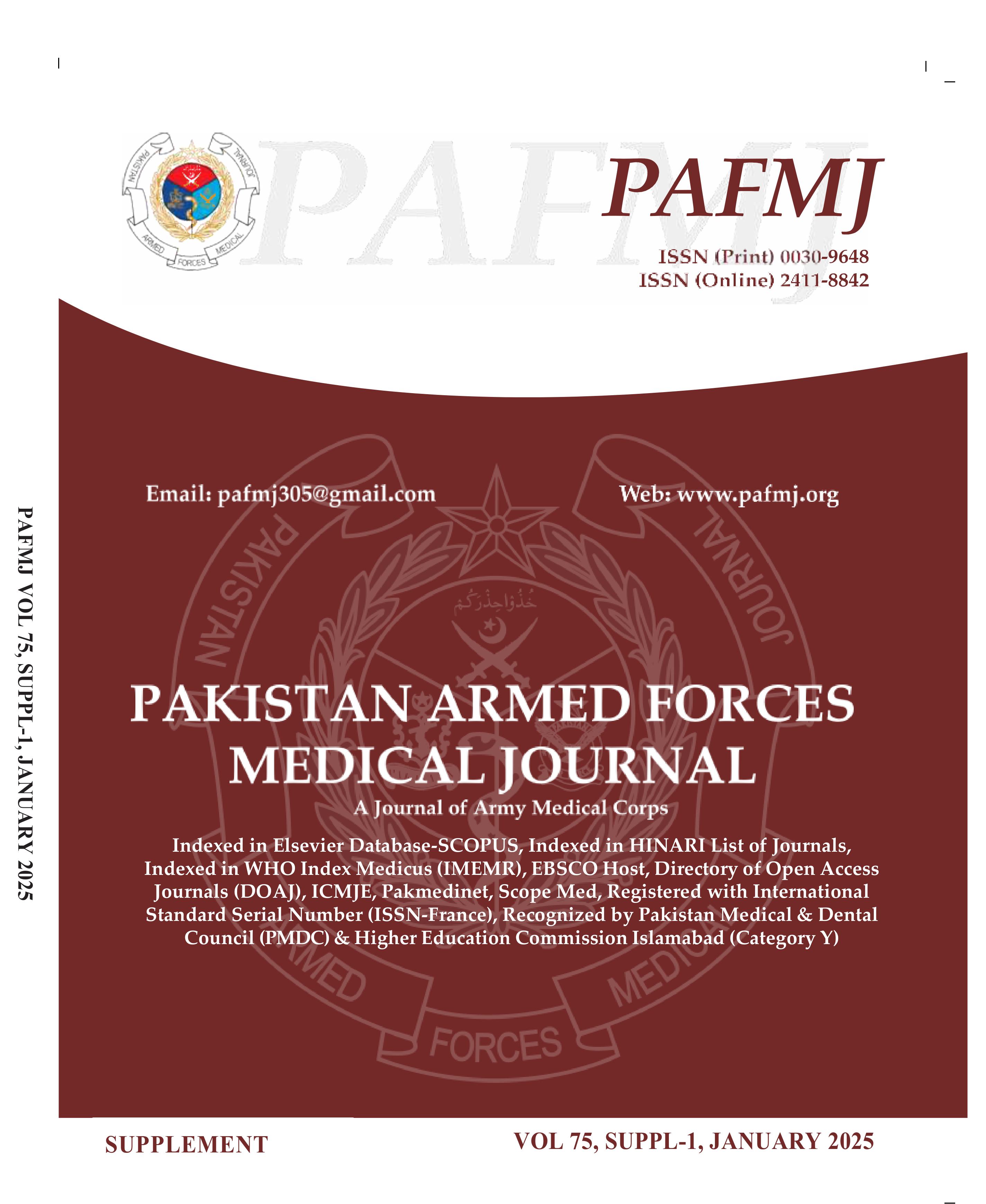A Study of Anti Microbial Resistance in Salmonella Enterica Serovars Typhi and Paratyphi A At CMH Quetta
DOI:
https://doi.org/10.51253/pafmj.v75iSUPPL-1.11059Keywords:
Antibiotic Reistances, Enteric fever, salmonella enterica typhi, and salmonella enterica paratyphiAbstract
Objectives: To ascertain the antimicrobial resistance of Paratyphi A and Typhi Serovars of Salmonella Enterica
Study Design: Prospective Observational Study
Place and Duration of Study: Clinical Microbiology Laboratory at the CMH Quetta November 2022-Septmeber 2023
Patients and
Methodology: The data from the lab were reviewed in this investigation Blood cultures from 1441 admitted patients from the Medicine department supplied to the laboratory of the CMH Quetta between November 2022 and September 2023 were tested for antibiotic susceptibility and Typhoidal Salmonellae were isolated.
Results: Out of total 1441 isolates, 839(58.2%) were isolates of Salmonela Typhi and 602(41.8%) were S Paratyphi .These microbes had maximum resistance against Ceftriaxone (71.6%, 67.2%), Ciprofloxacin (70.6%, 66.6%). S typhi and paratyphi have minimal resistance to Meropenum 7.7% and 9.13% respectively. These patients had maximum sensitivity for Meropenum.
Conclusion: S. Typhi and S. Paratyphi have high rates of multidrug resistance against Ceftriaxone and Ciprofloxacin. Meropenum had found to have minimal resistance.
Downloads
References
Crump JA, Luby SP, Mintz ED. The global burden of typhoid fever. Bulletin of the World Health Organization. 2004 May;82 (5): 346-53.
Crump JA, Mintz ED. Global trends in typhoid and paratyphoid fever. Clinical infectious diseases. 2010 Jan 15;50 (2): 241-6.
Kothari A, Pruthi A, Chugh TD. The burden of enteric fever. The Journal of Infection in Developing Countries. 2008 Aug 1;2 (04): 253-9.
Britto CD, Wong VK, Dougan G, Pollard AJ. A systematic review of antimicrobial resistance in Salmonella enterica serovar Typhi, the etiological agent of typhoid. PLoS neglected tropical diseases. 2018 Oct 11;12 (10): e0006779.
World Health Organization. Background document: the diagnosis, treatment and prevention of typhoid fever. World health organization; 2003.
Crump JA, Sjölund-Karlsson M, Gordon MA, Parry CM. Epidemiology, clinical presentation, laboratory diagnosis, antimicrobial resistance, and antimicrobial management of invasive Salmonella infections. Clinical microbiology reviews. 2015 Oct;28 (4): 901-37.
Kumar S, Rizvi M, Berry N. Rising prevalence of enteric fever due to multidrug-resistant Salmonella: an epidemiological study. Journal of medical microbiology. 2008 Oct 1;57 (10): 1247-50.
Threlfall EJ, Fisher IS, Berghold C, Gerner-Smidt P, Tschäpe H, Cormican M, Luzzi I, Schnieder F, Wannet W, Machado J, Edwards G. Trends in antimicrobial drug resistance in Salmonella enterica serotypes Typhi and Paratyphi A isolated in Europe, 1999–2001. International journal of antimicrobial agents. 2003 Nov 1;22 (5): 487-91.
Klemm EJ, Shakoor S, Page AJ, Qamar FN, Judge K, Saeed DK, Wong VK, Dallman TJ, Nair S, Baker S, Shaheen G. Emergence of an extensively drug-resistant Salmonella enterica serovar Typhi clone harboring a promiscuous plasmid encoding resistance to fluoroquinolones and third-generation cephalosporins. MBio. 2018 Mar 7;9 (1): 10-128.
Qamar FN, Yousafzai MT, Khalid M, Kazi AM, Lohana H, Karim S, Khan A, Hotwani A, Qureshi S, Kabir F, Aziz F. Outbreak investigation of ceftriaxone-resistant Salmonella enterica serotype Typhi and its risk factors among the general population in Hyderabad, Pakistan: a matched case-control study. The Lancet Infectious Diseases. 2018 Dec 1;18 (12): 1368-76.
Capoor MR, Nair D, Deb M, Aggarwal P. Enteric fever perspective in India: emergence of high-level ciprofloxacin resistance and rising MIC to cephalosporins. Journal of medical microbiology. 2007 Aug;56 (8): 1131-2.
Hasan R, Zafar A, Abbas Z, Mahraj V, Malik F, Zaidi A. Antibiotic resistance among Salmonella enterica serovars Typhi and Paratyphi A in Pakistan (2001-2006). The Journal of Infection in Developing Countries. 2008 Aug 1;2 (04): 289-94.
Bhattacharya SS, Das U, Choudhury BK. Occurrence & antibiogram of Salmonella typhi & S. paratyphi A isolated from Rourkela, Orissa. The Indian journal of medical research. 2011 Apr;133 (4): 431.
Naz F, Azmatullah A, Zaidi A. A three year review of antimicrobial resistance of Salmonella enterica serovars Typhi and Paratyphi A in Pakistan. International Journal of Infectious Diseases. 2014 Apr 1;21:82.
Lugito NP. Antimicrobial resistance of Salmonella enterica serovars Typhi and Paratyphi isolates from a general hospital in Karawaci, Tangerang, Indonesia: A five-year review. International Journal of Microbiology. 2017;2017.
Ugboko H, De N. Mechanisms of Antibiotic resistance in Salmonella typhi. Int J Curr Microbiol App Sci. 2014 Aug 8;3(12):461-76.
Anggraini AB, Opitasari C, Sari QA. The use of antibiotics in hospitalized adult typhoid patients in an Indonesian hospital. Health Science Journal of Indonesia. 2014 Jun;5 (1): 40-3.
Chand HJ, Rijal KR, Neupane B, Sharma VK, Jha B. Re-emergence of susceptibility to conventional first line drugs in Salmonella isolates from enteric fever patients in Nepal. The Journal of Infection in Developing Countries. 2014 Nov 13;8 (11): 1483-7.
Butt T, Ahmad RN, Salman M, Kazmi SY. Changing trends in drug resistance among typhoid salmonellae in Rawalpindi, Pakistan. EMHJ-Eastern Mediterranean Health Journal, 11 (5-6), 1038-1044, 2005. 2005.
Maskey AP, Basnyat B, Thwaites GE, Campbell JI, Farrar JJ, Zimmerman MD. Emerging trends in enteric fever in Nepal: 9124 cases confirmed by blood culture 1993–2003. Transactions of the Royal Society of Tropical Medicine and Hygiene. 2008 Jan 1;102 (1): 91-5.
Menezes GA, Harish BN, Khan MA, Goessens WH, Hays JP. Antimicrobial resistance trends in blood culture positive Salmonella Typhi isolates from Pondicherry, India, 2005–2009. Clinical Microbiology and Infection. 2012 Mar 1;18 (3): 239-45.
Lakshmi V, Ashok R, Susmita J, Shailaja VV. Changing trends in the antibiograms of Salmonella isolates at a tertiary care hospital in Hyderabad. Indian journal of medical microbiology. 2006 Jan 1;24 (1): 45-8.
Downloads
Published
Issue
Section
License
Copyright (c) 2025 Haseeb Nasir, Hassan Shabbir, Nadia Tayyab, Sayed Tanveer Abbas, Maryam Zafar

This work is licensed under a Creative Commons Attribution-NonCommercial 4.0 International License.















